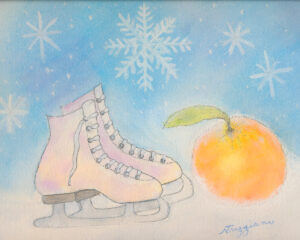“He came”! He came”! I can still hear my not-so-dainty bare feet thumping, as I ran towards the Christmas tree. Glowing with warm colored lights, glittering tinsel, and sparkling handblown glass ornaments, it was magical! Excited to see the toys below, I dashed into the kitchen to make sure the cookies left on the table for Santa had been eaten. The remains of a bitten cookie and crumbs was all the evidence I needed, confirming that it really was Santa who had placed the gifts beneath the tree.
Poking my head into my parent’s bedroom, I repeated, “He came”! Clarifying, “Santa was here”! I roused them from what certainly must have been a long, uninterrupted, restful Christmas Eve’s sleep. Mom put on her robe as Dad grabbed his camera. The three of us, up shortly before the sun, walked towards the living room, illuminated by the rack of lights atop Dad’s movie camera.
First, I dashed to get my Christmas stocking, hung, not from the mantle, as our Paterson, New Jersey home had no fireplace, but rather from the large key in the cabinet door of the grandfather’s clock. A wintery off-white stocking, adorned with glitter and sequins, was stuffed with little toys, treats, and a candy cane sticking out the top. At the very bottom, nestled in the toe, the very last thing to pull out, sat an orange. Every year there were different toys beneath the tree and different goodies in the stocking, but there was always an orange at the bottom.
I never knew why Santa always put an orange in my stocking, and looking back, I wonder why I never asked. Nonetheless, a Christmas stocking would never be complete without an orange. Only recently did I start investigating the reasons behind this. As it turns out, there are several origins of the Christmas orange.
Traveling back in time to the 4th century AD, legend has it that a very poor man with three daughters didn’t have enough money for their dowries. Hearing of this, St. Nicholas dropped three round pieces of gold down their chimney, and they landed in the girl’s stockings drying below. The round orange with its goldish hue, came to symbolize the balls of gold given by St. Nicholas.
Fast forwarding to the 1800s, oranges, native to warm climates, were exotic and rare in colder regions. The slow modes of transportation of the era meant oranges came with a hefty price tag. Only the rich could afford this sweet citrus fruit, so gifting an orange was regarded as giving someone a luxury item.
During the Depression and the lean years that followed, people didn’t have money to spend on gifts. Many struggled just to put food on their table and oranges were regarded as an extra special treat. Without the financial ability to put gifts and toys under the tree, an orange, sometimes accompanied by nuts, was placed in a Christmas stocking.
Only now, as an adult, do I understand why my parents, tired from secretly playing Santa, happily watched and filmed me pulling out the orange they had placed in the toe of my Christmas stocking.
Along with an orange, there was one other thing I got every year for Christmas – ice skates! From the first year that I graduated to single blade skates, up until my preteens, there was always a box of new ice skates for my bigger, growing feet under the tree. Tucked in the box was a pair of wool socks – skating socks – to keep my feet warm. Read more

